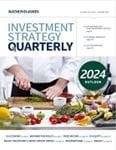First Trust Monday Morning Outlook
Brian S. Wesbury - Chief Economist
Robert Stein, CFA - Dep. Chief Economist
January 29, 2024
The economy is still growing. Real GDP rose at a solid 3.3% annual rate in the fourth quarter, and consumer spending was strong in December meaning the first quarter is off to a good start. New home sales came in above expectations and initial jobless claims remain low, although orders for durable goods came in low due to weak demand for aircraft.
All eyes are now on Friday’s jobs report, which we expect to show a gain of about 170,000 while the unemployment rate holds steady. But the strength in employment seems fragile. If we exclude job gains in government, health & education (which are largely funded by government), and leisure & hospitality (still recovering from lockdowns), job growth looks exceptionally weak. In the last seven months of 2023, payrolls excluding those categories rose only 3,000 per month, the kind of weakness we might expect before a recession. In other words, much of recent growth is fueled by government deficits.
Meanwhile the stock market continues to rally, with the S&P 500 closing at a new record high last Thursday. That’s great, but we aren’t exactly sure what the market sees.
If the economy remains healthy and keeps growing, it’s very hard to imagine the Federal Reserve cutting short-term interest rates by the 125-150 basis points the markets appear to expect. In turn, less rate cutting than the market expects should be a headwind for equities in 2024.
What would get the Fed to cut rates by 125-150 bps? Either a sharp drop in inflation or a decline in economic growth. While lower inflation is good, can a sharp drop happen without a weak economy? Either way, we don’t think the stock market would like that outcome because they would likely signal lower corporate profits.
This is all consistent with our Capitalized Profits Model, which still says stocks are overvalued. That model uses economy-wide profits from the GDP accounts (excluding profits or losses by the Fed) and discounts them by the 10-year Treasury yield. Using the level of profits in the third quarter (we won’t get Q4 numbers for profits until the end of March) and a 10-year yield of 4% (which was its yield before rate cut expectations started to evaporate), suggests the S&P 500 would be fairly valued at about 3,900, well below recent highs.
What would it take to suggest that recent stock prices are appropriate? A 10-year yield of 3.2% would do it. So would a 30% increase in profits. But a 3.2% yield would probably be accompanied by lower profits and a 30% surge in profits would likely be accompanied by a much higher 10-year yield, so fair value is even further away than it seems.
The only way out of this conundrum is if Artificial Intelligence and other new and rapidly advancing technologies provide a miraculous boost to productivity. This could keep growth strong, or even accelerate it, while bringing inflation down. In other words, profits up and interest rates down.
While this could happen, it would take a miracle. And while expecting miracles worked for San Francisco fans, we still think investors should remain cautious. The monetary and fiscal stimulus that made COVID lockdowns seem like a bump in the economic road are wearing off.
The attached information was developed by First Trust, an independent third party. The opinions are of the listed authors at First Trust Advisors L.P, and are independent from and not necessarily those of RJFS or Raymond James. All investments are subject to risk. There is no guarantee that these statements, opinions, or forecasts provided in the attached article will prove to be correct. Individual investor's results will vary. Past performance does not guarantee future results. Forward looking data is subject to change at any time and there is no assurance that projections will be realized. Any information provided is for informational purposes only and does not constitute a recommendation. Investing involves risk and you may incur a profit or loss regardless of strategy selected. The S&P 500 is an unmanaged index of 500 widely held stocks that is generally considered representative of the U.S. stock market.
























